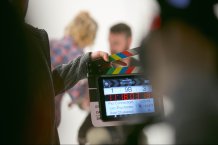
Currently, deepfakes fall outside the scope of protection afforded by performers' rights
Giving performers copyright over their work could protect them from being cloned by deepfake technology, a study says.
AI and other technology is increasingly being used to make fabricated videos or sound recordings that imitate the likeness of a person's face, voice or performance by manipulating authentic footage using machine learning technology.
Regulating the abusive use of deepfake technology is challenging because it was unforeseen by intellectual property policy-makers at the time current laws were designed.
Currently performers are legally entitled to control the records made of their work, but this doesn't apply to digital impersonation such as those generated by deepfakes.
New research by Dr Mathilde Pavis, from the University of Exeter Law School, suggests existing performers' legal rights should be reformed, so they have copyright over their performances instead.
The research is published in Convergence: The International Journal of Research into New Media Technologies.
The study says reforming performers' rights would be a sophisticated response to the challenges posed by deepfake technology. This would mean performers and others could better use positive aspects of deepfake technology for creative expression, or entertainment in television, films, video games or social media.
Dr Pavis said: "The regime of performers' rights could be replaced with a regime of performers' copyright. This small, yet important, change in legal regimes can be the difference between piecemeal, uneven and, therefore, ineffective protection against unauthorized deepfakes and a harmonized international approach to the technology.
"This reform would offer a comprehensive and more sustainable legal response to deepfakes. It would simplify the structure of intellectual property by removing a sub-category of intellectual property right - performers' rights - and integrating it into the more-established regime of copyright. It would remove the archaic divide placed between authors and performers, which has no legitimate justifications today.
"This reform would create transferable property rights over the performance and likeness of the deepfaked persons. There will need to be safeguards included, such as preventing or limiting the complete transfer of rights to third parties."
Performers' rights currently protect the recording of a performance and the reproductions (or copies) of that recording. Performers can only control the fixed, recorded, version of their performance. The content of the recording, the performance, is not protected and can be re-performed and imitated without consequences under performers' rights. This means that a performer has no intellectual property right to the substance or style of their performance.
Deepfakes challenge the framework of performers' rights because performances are reproduced without generating a 'recording' or a 'copy' of a recording. AI systems used to generate deepfakes do not record performances or copy recordings of performances. They reproduce performances without reproducing the recordings of those performances so fall outside the scope of protection afforded by performers' rights.
Including the making of deepfakes within the scope of activities controlled by performers' rights would require a modification of the statutory provisions defining the right to record a performance, and the right to make copies of these recordings to ensure that it covers reproduction of the performance itself, or at least references reproduction of performances via synthetisation.
In the UK, such modifications would have to be made to Sections 182 and Sections 182A of the CDPA, 1988. Under international law, equivalent modifications would have to be made to corresponding provisions, those being Articles 3 and/or Article 7 of the Rome Convention, and Articles 2, 6 and 7 of both the WPPT, 1996 and the Beijing Treaty (2012).






